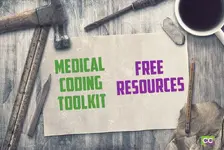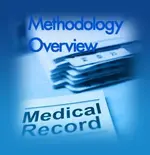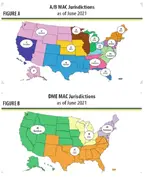Medicare Provider Compliance Tips List
Ambulance Services- Annual Wellness Visits
- Anticancer Drugs
- Bacterial Cultures
- Blood Counts
- Canes & Crutches
- Cataract Services
- Chiropractic Services
- Commodes
- CORF Services
- CPAP Devices
- Diabetic Shoes
- Diabetic Supplies
- Echography & Sonography
- Enteral Nutrition
- Enteral Nutrition Pumps
- ESRD Clinic Services
- Home Health Services
- Hospital-Based Hospice Services
- Hospital Beds
- Immunosuppressive Drugs
- Infusion Pumps
- Inpatient Rehabilitation Services
- Lenses
- Lipid Panels
- Lower Limb Orthoses
- Lower Limb Prostheses
- Manual Wheelchairs
- Nebulizers & Drugs
- Negative Pressure Wound Therapy
- Ostomy Supplies
- Other Lab Tests
- Oxygen
- Parenteral Nutrition
- Patient Lifts
- Physical Therapy
- Podiatry
- Pressure Reducing Support Surfaces
- Psychiatric Care
- Sleep Studies
- SNF Services
- Spinal Orthoses
- Surgical Dressings
- TENS Units
- Tracheostomy Supplies
- Urinalysis
- Urological Supplies
- Venipuncture
- Ventilators
- Walkers
- Wheelchair Options
×
DMEPOS General Documentation Requirements
Documentation requirements apply to certain Durable Medical Equipment, Prosthetics, Orthotics, and Supplies (DMEPOS) items.
All claims billed to Medicare require a written order or prescription from the treating practitioner as a condition for payment. The written order or prescription must meet Standard Written Order (SWO) requirements.
To justify payment, suppliers must meet these requirements:
- SWO
- Medical record information (including continued need and use if applicable)
- Correct coding
- Proof of delivery (POD)
Note: Section 5.10 of
Medicare Program Integrity Manual, Chapter 5 states that suppliers must keep POD in their files for 7 years, starting from the date of service, and must provide documents to their Durable Medical Equipment Medicare Administrative Contractor (DME MAC) upon request.
The treating practitioner must communicate a SWO to the supplier before submitting a claim. For certain DMEPOS items, we require a Written Order Prior to Delivery before delivering the item(s) to the patient.
A SWO must have:
- Patient’s name or MBI
- Order date
- General item description
- Description can be a general description (for example, wheelchair or hospital bed), an HCPCS code, an HCPCS code narrative, or a brand name or model number
- For equipment: Besides description of a base item, the SWO may include all concurrently ordered options, accessories, or other features that are separately billed or require an upgraded code (list each separately)
- For supplies: Besides description of a base item, the SWO may include all concurrently ordered supplies that are separately billed (list each separately)
- Dispensed quantity, if applicable
- Prescriptions may be refillable
- Treating practitioner name or NPI and signature
Signature and date stamps aren’t allowed, with a few exceptions. You must follow our signature requirements in section 3.3.2.4 of
Medicare Program Integrity Manual, Chapter 3.
Complying with Medical Record Documentation Requirements and
Complying with Medicare Signature Requirements fact sheets have more guidance.
Note: Local Coverage Article (LCA): Standard Documentation Requirements for All Claims Submitted to DME MACs (A55426) has more information about these requirements.
×
Lab Test Order Requirements
- You, the physician, practitioner, or NPP who’s treating the patient (and who provides a consultation or treats them for a specific medical problem and uses the results to manage their specific medical problem) must order the tests. Tests you haven’t ordered for treating the patient aren’t reasonable and necessary.
- Document medical necessity in the patient’s medical record when ordering the service.
- The entity submitting the claim must keep documentation from you, which includes:
- Documentation of the order for the service billed (including information which allows us to find and contact the ordering provider)
- Documentation showing accurate order processing and claim submission
- Diagnostic or other medical information you provided to the lab (including any ICD-10-CM code or narrative description)
Diagnostic lab test orders require 1 of these:
- Signed order or signed requisition listing the specific test
- Unsigned order or unsigned lab requisition listing specific tests done and an authenticated medical record that supports your intent to order the tests (for example, order labs, check blood, or repeat urine)
- Authenticated medical record that supports your intent to order specific tests
Note: Section 6.9.1 of
Medicare Program Integrity Manual, Chapter 6 has more information on order requirements.
You can deliver an order through:
- Written and signed document that’s hand delivered, mailed, or faxed to the testing facility. We don’t need your signature on orders for clinical diagnostic tests paid based on the clinical lab fee schedule, physician fee schedule, or for physician pathology services.
- Call from you or your office to the testing facility.
- Email from you or your office to the testing facility.
Section 80.6 of
Medicare Benefit Policy Manual, Chapter 15 has more information.
Note: If you communicate the order by phone, you or your office staff and the testing facility must document the call in the respective patient’s medical record. We don’t require a signed order, but you must clearly document in the medical record your intent to do the test.
Complying with Medical Record Documentation Requirements and
Complying with Medicare Signature Requirements fact sheets give more guidance.
Medical record documentation should include enough information to show the ordered or provided tests are reasonable and necessary, per
42 CFR 410.32.
Signature and date stamps aren’t allowed, with a few
exceptions.
×
“Other” Errors
“Other” errors include duplicate payment, non-covered or unallowable service, or ineligible Medicare patient errors.
Provider Compliance
www.cms.gov







